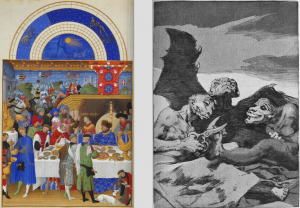As we transition from looking at illuminations to looking at prints (and in light of our recent comparative paper), I have started comparing and contrasting the notion of illumination with that of printing. It seems as though the goals of illumination and printing are similar: to create an aesthetically pleasing work of art that provides an accompanying narrative. In illuminations such as Books of Hours, the narrative is hidden in metapictures and background details. The narrative is a bit more overt in prints such as Los Caprichos, as the crude prints provide commentary in a much more “in your face” fashion. So, the content of the illuminations and prints share many components (e.g. strong narrative and artistic appeal).
These side-by-side works provide insight into this difference. Each of the works provides some commentary on a social issue. The print (by Goya) paints a caricature of high-society by showing demonic creatures giving one another makeovers. Similarly, the presence of the working class throughout illuminations in the Tres Riches Heures (just like the one shown here) provide commentary on the place of the working class in society. Thus, both works aim to say something about the time period during which they were created. Where printing and illumination differ, however, is in their creation.
We have had the opportunity to watch several videos and read a few articles that have given us insight into the process of illumination and printmaking. The video we watched in class on Wednesday showed just how difficult it can be to create a print. The aquatint technique used in Los Caprichos requires attention to detail and the investment of a lot of time. Interestingly, the way prints are created allows them to be created in mass – adding to their availability to all types of people while simultaneously subtracting from their uniqueness. We have also learned a lot about the process of illumination through My Name is Red, The Secret of Kells, the scriptorium workshop, and various articles. Creating an illuminated manuscript requires making inks, creating the parchment, and then actually producing a final illumination. Hence, the process of illumination certainly takes a great deal of time as well. However, illuminations are unique and cannot be easily reproduced, limiting their availability to those with better resources. These differences in technique are interesting to consider, though the goal of illumination and printing is very similar.


I really appreciate your take on the similarities and differences between the two forms of art. Especially since you point out the fact that both forms have similar goals, but the methods that are used to achieve these goas differe drastically. It will be interesting to carry this mindset of making connections throughout the different methods of creating images in books we will encounter in the future.
It is interesting to think about the differences between illumination and printmaking. I liked how you pointed out that though each styles of illustration are very difficult to make and require a long process, but the fact that illuminations can’t be reproduced as prints can makes them more unique. This certainly makes the illuminations more special and valuable, but it limits their audience, and if the one illumination is ruined then it is gone forever.